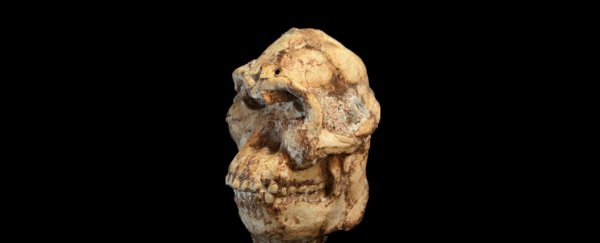A new dating technique suggests a possible human ancestor known as 'Little Foot' may have roamed South Africa as far back as 3.7 million years ago. This is close to a million years earlier than previous estimates thought.
Ever since the discovery of Little Foot in a cave in South Africa during the early '90s, researchers have argued about the age of the human-like skeleton with proportionately tiny feet, and an unusual skull.
Dating the remains has proven quite a challenge, because the fossilised skeleton is too old to use radiocarbon methods on. This means researchers need to date the rocks around it, but rains have caused sediments from different time periods to mix together, making it difficult for them to know with certainty whether the rocks encasing Little Foot's diminutive frame were from the time of his death, or much later.
As a result of this uncertainty, researchers have had trouble placing Little Foot into the family tree of human evolution.
Little Foot is considered the most complete australopithecine skeleton ever found, which, as Charles Choi explains for LiveScience, "are the leading candidates for direct ancestors of humans, living about 2.9 million to 4.1 million years ago."
This group includes the famous Lucy, Australopithecus afarensis, who lived and walked upright 3.2 million years ago near modern-day Ethiopia.
She was previously believed to be the oldest would-be human ancestor, but new dating techniques have revealed that Little Foot might have lived around the same time, and possibly even earlier. The results have been published in Nature.
"The most important implication from dating Little Foot is that we now know that australopithecines were in South Africa early in their evolution," lead author Darryl Granger from Purdue University in the US told Choi. "This implies an evolutionary connection between South Africa and East Africa prior to the age of Little Foot, and with enough time for the australopithecine species to diverge."
"Little Foot's new date is a reminder that there could well have been many species of Australopithecus extending over a much wider area of Africa than just the small number of fossil sites in East Africa and South Africa," study co-author Ronald Clarke, a paleoanthropologist at the University of the Witwatersrand in Johannesburg, told Bruce Bower at Science News.
Clarke, who first found the skeleton, has worked for more than 15 years to free much of Little Foot from the rock encasing it.
Bruce Bower explains how the research team arrived at their date for Science News:
"Granger and his colleagues measured the decay of radioactive forms of aluminum and beryllium in 11 samples from quartz surrounding Little Foot's skeleton. Decay of each element occurs at known rates shortly after sediment is buried. Nine of the 11 samples displayed comparable levels of decay, the researchers say, indicating that the rock was deposited on a single occasion. Calculations based on decay rates of each radioactive substance produced the new age estimate."
The authors are say Little Foot might belong to a new species called Australopithecus prometheus. But some researchers are sceptical about the early date and the technique, says Michael Balter from Science Magazine.
Geoarchaeologist Andy Herries of La Trobe University in Melbourne, Australia told Science News that "few, if any," fossil deposits in South Africa date to as early as 3.67 million years ago.
Until a more detailed anatomical analysis is done, it appears the debate will rage on.
Sources: Science News, Live Science, Science Magazine
